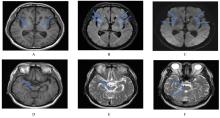吉林大学学报(医学版) ›› 2023, Vol. 49 ›› Issue (6): 1620-1624.doi: 10.13481/j.1671-587X.20230629
以精神障碍为首发症状的肝豆状核变性1例报告及文献复习
- 吉林大学第一医院肝胆胰内科,吉林 长春 130021
Hepatolenticular degeneration with mental disorder as first symptom:A case report and literature review
Feifei JIA,Hao ZHOU,Xin YANG,Ruotong XING,Xinrui WANG,Yanjun CAI,Wanyu LI( )
)
- Department of Hepatobiliary Pancreatology,First Hospital,Jilin University,Changchun 130021,China
摘要:
目的 分析1例以精神障碍为首发症状的肝豆状核变性(WD)患者的临床表现、发病机制、诊断和治疗方法,以提高临床医生对WD的认识。 方法 收集1例神经精神系统表现明显的WD患者的临床资料,分析其临床特点和诊治方法,并结合相关文献进行复习。 结果 患者,男性,47岁,9年前出现震颤,检查后诊断为肝硬化失代偿期,考虑乙醇所致可能性大;8年前出现妄想和恐惧等精神症状,诊断为精神分裂症。入院查体慢性肝病面容,神志清楚,四肢姿势性震颤伴有静止性震颤,肌张力增强,运动迟缓,语言失能。检查发现铜蓝蛋白和血清铜较低,24 h 尿铜明显升高,角膜色素(K-F)环阳性,基因检测ATP7B在8号外显子上有2处点突变,根据WD中Leipzig评分系统评分为8分,诊断成立。进一步核磁共振成像(MRI)检查提示双侧豆状核、中脑和脑桥异常信号,符合WD表现。应用二疏丙磺钠联合锌剂驱铜治疗后,患者尿铜先升高后逐渐降低。驱铜3个疗程后,患者神经系统症状减轻,表现为震颤稍减轻,可与家人进行简短词语交流,可以短距离步行,说明治疗有效。 结论 对于以精神障碍为首发症状的WD患者,结合肝脏受累,临床应注意鉴别,尽早完善铜蓝蛋白、眼科K-F环和头部MRI检查,必要时完善基因检测和(或)肝穿刺活检,一旦确诊WD,应尽早开始驱铜治疗,减少误诊和漏诊的发生。
中图分类号:
- R742.4


